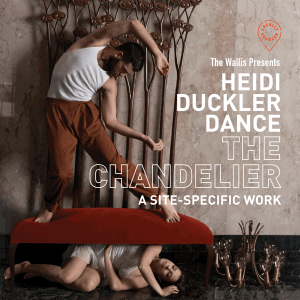
In 1946, in the aftermath of the Second World War and amidst a world trying to find itself again, Brazilian writer Clarice Lispector published her second novel. It’s repetitive structure and limited plot tell a young girl’s coming of age story and her disconnection from the world around her. The Chandelier was translated into English for the first time in 2018, and is the inspiration for Heidi Duckler Dance’s latest work, Illuminating the Chandelier, which premiered online on April 30, 2020, and now lives perennially on the internet.
HDD closed out the country’s first full month of quarantine with an online “abbreviated” performance that calls into question our collective reality and identity. As a site-specific dance company, HDD has performed at the Wende Museum in Culver City, under a freeway overpass and now, online. A pre-performance of sorts, appearing months before HDD’s The Chandelier shows at the Wallace in the Fall of 2020, Illuminating the Chandelier is the scrappy response to a national crisis.
“I feel like it was a very different world then, right after the war,” said Duckler a few days before the show, talking about the world Lispector’s novel was published in. “It was a time when people were trying to make sense of the huge crisis situation and coming out a little bit feeling like prisoners.”
In that sense, Illuminating the Chandelier is timelier than ever. In Lispector’s work, plot is scarce, and time is relative. These themes are not forgotten in HDD’s performance. Frames are either filled to the brim with people, or feature a single performer, usually in a subway station, rotating as if on display, or putting on clothes. Dancers performing alone in their living rooms and bedrooms are layered over each other, creating mosaics like the one in “Scene Five: Party in the City / Dinner in the Country.” Three boxes display varying tableaus, the upper right box threading together repetitive scenes from the home: five dancers pick up a spoon from a bowl, bring it to their mouths, but lower the utensil before touching their lips with a mixture of shock and surprise, or whatever the viewer recalls in the expressions of these performers. Some of these moments are happening live while others have been previously recorded, dangling the concept of reality over the viewer.
Music by Sarah Belle Reid and Isaac Takeuchi bring a pensive and despairing mood, and the costumes – selected from dancer’s closets by costume designer Snezana Petrovic over video chat – anchor the scenes to the era. Self-admittedly, the performance is “full of imperfections,” but does what HDD does best: adapt to the surroundings.
I found myself constantly snapping in and out of a visual truth of sorts, watching, as I’m used to, an entirely in-the-moment performance, and then recalling with a jolt that not everything I see is happening now. That’s the power of this confusing work: it’s not a comfortable, fluid piece. Instead, it jumbles, shakes, grows and shrinks.
In my research of Lispector, the jury was unanimous: her work is complicated and meant to be enjoyed slowly, “sipped and savored” as one reviewer put it. It is a book difficult to unpack. In a similar vein, I find Duckler’s “Illuminating the Chandelier” hard to observe only once, for all the intricate layers colliding in frames within frames. Like the book, it is something to be explored over and over again.
“Illuminating the Chandelier” is available to watch on the internet for the foreseeable future. As noted in their pre-show notes, settle into something comfortable, grab a drink, and enjoy the show.
Elizabeth Moss


Be the first to comment